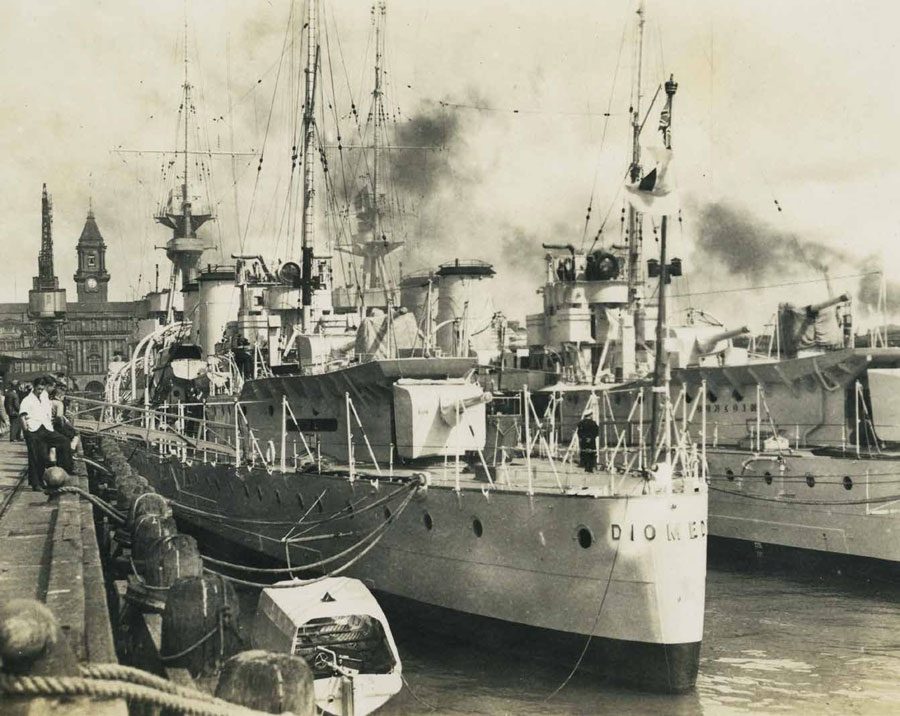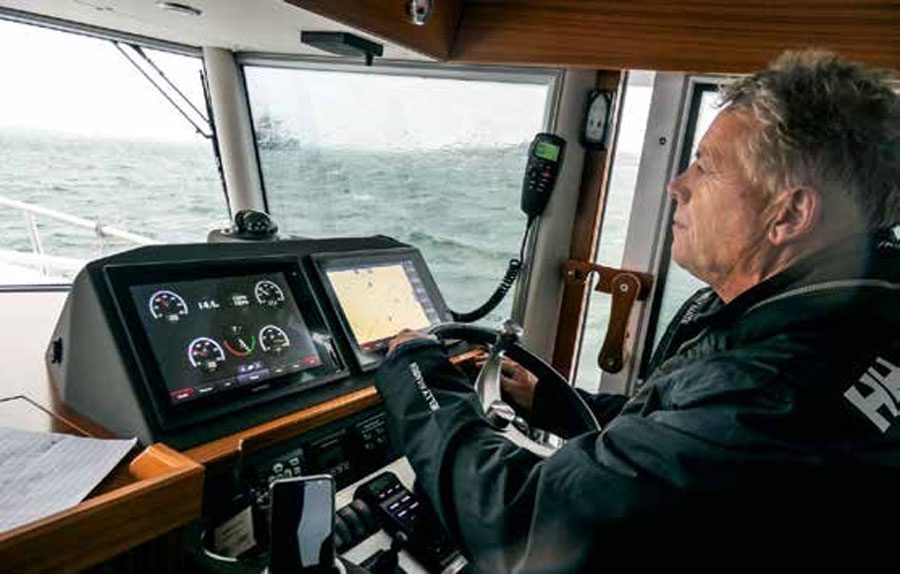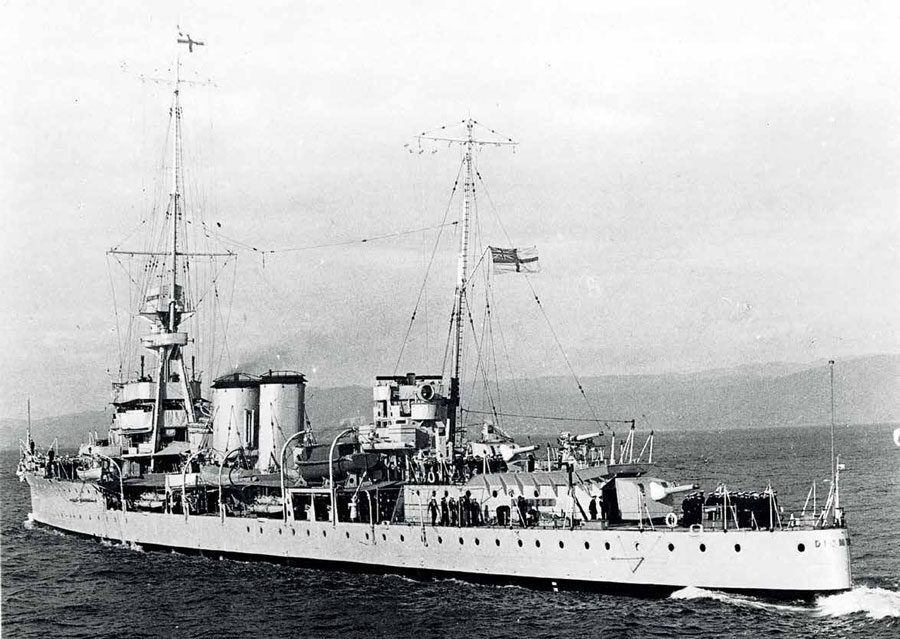

After Shenandoah was launched in December 1929, Harry Jenkins had little time to enjoy his wonderful new launch peacefully. Two months before, the world had been thrown upside down in the New York stock market crash.
Harry’s business interests were in Gane Milking Machine Company and Gane Engineering Ltd, sound businesses but highly exposed to downturns in the farming and engineering sectors. Run by Noel Paton and his son Eric Paton, Gane Engineering was getting a great reputation for high quality engineering. In 1926 the company designed, built, and installed the clock in the tower of the new university in Princes Street.
Harry’s business and political career suffered major setbacks once the Depression bit deeper into the community. The growth of the Gane company was tied to the farming industry. Butterfat had been 2/6d (25c) a pound in 1920. It was now down to 11 ½d, less than the cost of production. Dairy farmers were beginning to walk off their farms. They were unable to invest in the new milking machinery which could have lifted their profits.

In November 1928 Harry won his election as MP for Parnell in Sir Joseph Ward’s United Party on a Free Trade ticket and as spokesman for railways. In February 1930, just out of hospital after his near-death experience in Mechanics Bay (Vintage Viewpoint, February), and possibly because of it, Harry found himself disenchanted with the politicians around him. He declared himself an Independent, unable to continue as a United Party member, declaring his preference for the policies of Gordon Coates’ Reform Party. He was looking towards a National coalition government to get the country through the Depression. In the political turmoil that followed, Harry resigned his seat in Parliament, forcing a by-election in May 1930. While Harry put his name forward as a candidate for the Reform Party, he was beaten by Bill Endean, who took the seat.
From this time Harry’s life appeared to change. His political views had hardened. He joined the Squadron for the first time. With his family he cruised the Hauraki Gulf in Shenandoah during most of the Christmases, often in company with the Guthrie family in their Alcestis and the Wiles family in Lady Margaret II.

Alcestis was a 45ft double-ender, built as Mollie in 1919 by Joe Slattery in Judges’ Bay for P.R. Colebrook and bought by H.D. Guthrie of Guthrie Bowron in 1928. Guthrie commissioned Colin Wild to raise the cabin top, remove its Auckland-built Twigg engine and replace it with the four-cylinder 100hp Stearns petrol marine engine out of H.O. Wiles’ first Lady Margaret. She is still afloat in excellent condition as Raiona.
Harold Wiles started in business as a pharmacist in Queen Street but branched out in the 1920s by importing from the US everything from automotive-related merchandise to Kellogg’s cornflakes. By July 1924 H.O. Wiles Ltd of 65 Fort Street was the local importer of the ‘hot’ American-built Stearns petrol marine engines which had become the top choice for the new run of bridgedeckers then pouring out of Auckland boatbuilding yards and for re-powering the bigger launches like Romance II. Prices started at £300 for the four-cylinder 20hp, the price of a new house in a suburb like Westmere. The 1929 Lady Margaret was Wiles’ second launch of that name, a superb 42-footer designed and built by Colin Wild and powered by a sixcylinder 160hp Stearns.

As in many other matters Harry Jenkins had been way ahead of his time in specifying the high-powered, high-speed Cummins diesel for Shenandoah. The petrol engine was on its way out for marine applications for reasons of first cost, operating economy and security against the petrol fires which made many launches death traps, some disappearing on coastal passages with no trace except for an offshore flash of light at night.
In 1930 Harry put a lot of his resources into a tung oil, olive and tropical fruit plantation on 40,000 acres at Paeranga in the Far North. The Depression made failure inevitable. Again, it was too far ahead of its time. Harry survived this setback, selling the home in Remuera and moving the family to their bach at Kerikeri. Their elderly Rolls-Royce was next to go. All commitments were met; no staff were put off at Gane Milking Machine Company or at Gane Engineering Company.
Shenandoah continued to provide the Jenkins family of one son and three daughters with a strong focus. But one of Harry’s final trips in Shenandoah nearly ended in tragedy. In late December 1936 she was moored at Deemings yard in Opua. The Cummins diesel’s engine governor had been overhauled by Gane Engineering. Harry and his son Graham were driving it north at night when they ran into a car fixing a puncture in the middle of the road just before Kaiwaka. Harry’s car rolled several times down a hill and the governor was damaged. They got themselves to Opua and asked Deeming Bros to help, but they could not make it function.

On 25th December, despite the fact that he had only full throttle, Harry made the decision to sail Shenandoah south to pick up the family for their summer cruise. As crew he had his son Graham and two skilled yachtsmen, Brian Donovan and Phil Aldred. In calm conditions and perfect moonlight visibility, but motoring at full speed of about 12 knots, he suddenly struck fog off Cape Brett around 1:00am. He turned away and set a compass course to avoid Piercy Island.
Within minutes, Shenandoah piled up on a rock pinnacle off Piercy Island and nearly capsized. The heavy swell lifted her onto an even keel on a rock shelf. Graham and the two crewmembers jumped ashore. Harry cut the engine but had been thrown against the wheel and broken a rib. He stayed on board assessing the situation. Another large swell lifted Shenandoah clear and she was drifting off. Gritting his teeth, he released the dinghy from its chocks and swung it outboard. He found he could not anchor because both anchors had gone overboard with their warps in the crash.

Shenandoah was sinking from a hole forward. Harry had the task of getting the engine running with the compressed air start indicating low pressure, getting the bilge pumps working and then picking up his crew from the rocks with an ungoverned engine and near zero visibility. The petrol engine which drove the compressor was partially under water and out of action. Fortunately, the Cummins was warm and started with the remaining pressure in the tank.
The fog lifted a little. With his bow down two feet and Shenandoah down to six knots as a result, Harry was able to run past the crew and throw them a sinker attached to a light line bent on to the dinghy’s painter. They hauled in the dinghy and then judged the heavy swells to enable Graham to set out sculling her, half swamped, to the launch. With a four-gallon tin as a bailer Graham went back twice, dragging Brian and Phil back, hanging on to the stern. They frantically bailed Shenandoah out with four-gallon tins and got her up almost to her marks. Harry beached the launch at Urupukapuka Island where the crew patched the hole forward when the tide went out. She was towed up to Deemings at Opua for a permanent repair.
Later in 1937 Harry sold Shenandoah to Fred Chamberlin of Ponui Island. He had been well under way with an even more spectacular craft than Shenandoah, a yacht that could take him and his family all over the Pacific. He employed Chas Bailey Jr as designer and Deeming Bros as builders as they had shown their mettle with Shenandoah. The new boat was a very large ketch, 94ft long, 22ft beam and 10ft draught. Harry called it Golden Hind.

He embarked on the project with enormous energy. Chas. Bailey was retired from daily work at his yard and this was his last major design commission, a companion piece to Shenandoah. Deemings were in the North near the source of the kauri and pohutukawa needed for construction. There was then no shed in the country big enough to build her inside, so construction in the open on the foreshore at Opua was not an issue. Harry searched out kauri trees in the bush behind Opua, cut them down and towed the logs with Shenandoah to Deemings for milling for the triple diagonal construction. He selected the pohutukawa knees from inland trees and the fine native timbers for the interior panelling and furnishing. Deemings started construction in early 1937.
Her hull finally went into the water at high tide, 10am on July 20, 1939. She was then towed across to Opua Wharf to have fitted her 66hp Kelvin G3 diesel auxiliary, supplied by Walsh Bros, together with a 7hp Kelvin to power the lighting set and refrigeration. She arrived in Auckland on August 21, 1939 under power to have her spars fitted and her Boyd & McMaster sails bent on.
Harry told the press that he planned a voyage to England starting in early 1940. But Hitler had other plans. BNZ
ACKNOWLEDGEMENT
I gratefully acknowledge use of the Jenkins family history, And Not To Yield, by Thora Parker, Bateman, 1987.




